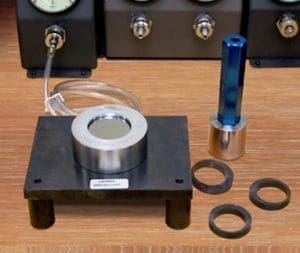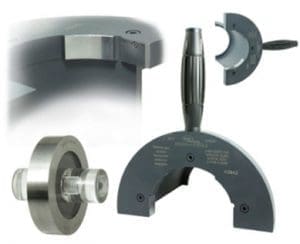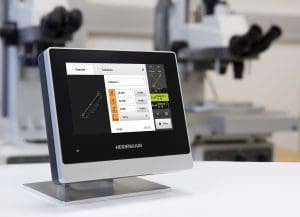
Fast And Accurate: Simple Fixtures For Hard To Get At Gaging Locations
George Schuetz, Mahr Inc.
Fast and accurate. Those words are near and dear to part inspection in the production environment. In a job shop, part inspection might be done in a small inspection area, say on a granite plate using height gages and indicators to measure the dimension. Or a CMM might be programmed to measure the part. But for mass production, this would not cut it. In a production environment critical part dimensions must be measured fast and accurately by the machine operator, at the point of manufacture.
That's where comparative gaging shines. Dedicated gaging optimizes the operator's ability to place the part on the gage and get a fast, accurate result. But sometimes unique features on a part can throw a wrench into the use of the typical fixed size gaging system. With a little thought and fixturing these challenges can be overcome.
Air gaging is the ideal fixed gaging design for fast and accurate. The body of the plug aligns the gage in the part so that there is no need for the operator to rock the part to find the diameter. But there is one feature that can make the gage difficult to use by the operator: narrow lands on the part ID. Sometimes the land may be just barely wide enough to cover the entire jet properly in order to make a good measurement. Thus, the jet must be placed almost perfectly on the land to get full coverage and a good result. But in a production environment the operator does not have time to place the plug in the part and search for the ID. The simplest way to remedy this is to employ a stop collar on the plug. The stop collar provides a simple but effective low cost solution to quickly locate the jets on the land repeatably and easily. Fast and accurate for any user.
The same might be true on an OD. I can think of two unique challenges here: the first being a thin part, and the second a thin diameter that needs to be measured in process while the part is still in the machine. Both challenges can be met by using proper accessories to stage the part.
In the case of the thin part, a special air ring can be built with a moveable platen built into it. The platen stops the part at the right location relative to the jets, almost like a stop collar. But while this is great for positioning the part, the part may be too thin for easy extraction by the operator. Here the platen could be spring-loaded. The rest position of the platen would be slightly higher than the gaging position. The operator just places the part in the gage and presses it down to the gaging location. After measurement, the part is ejected by the spring platen. Fast and accurate.
In the case of the thin OD, a sort of negative version of the stop collar can be made and attached to the air snap. An external half tube is added to the snap to rest against the face of a larger diameter at the precise distance for the jets to gage the land. This provides all the benefits of a snap gage, plus the ability to measure at a fixed location with no diameter searching by the operator.
Tough locations are not always related to dimensional measurements, though. In the case of surface finish, some locations may be below the datum surface and may be very narrow in width. In such cases there is no way an operator can manually position the gage to measure these locations quickly and obtain good results. But just as a stop collar can position an air plug, a surface gage template can also be made to properly position the gage to the surface under measurement. The template creates fixed gaging locations so that the operator can simply place the gage in the template to effect a fast and accurate measurement.
These simple fixture additions can go a long way to make gaging easier for the operator, eliminate operator influence, and greatly improve the performance of the measuring system. And that's what you want in a production environment: fast and accurate.

With a thin part, a special air ring can be built with a spring-loaded platen built into it. The platen stops the part at the right location relative to the jets, almost like a stop collar. The operator just places the part in the gage and presses it down to the gaging location. After the measurement, the part is ejected by the spring platen.

In the case of the thin OD, a sort of negative version of the stop collar can be made and attached to the air snap. An external half tube could be added to the snap to rest against the face of a larger diameter at the precise distance for the jets to gage the land.

